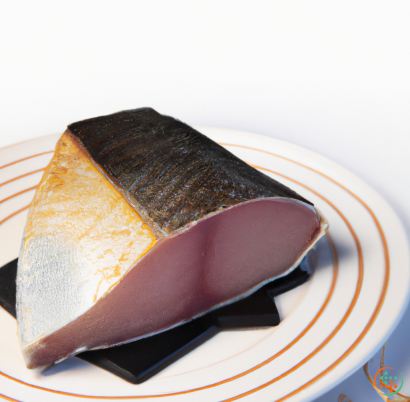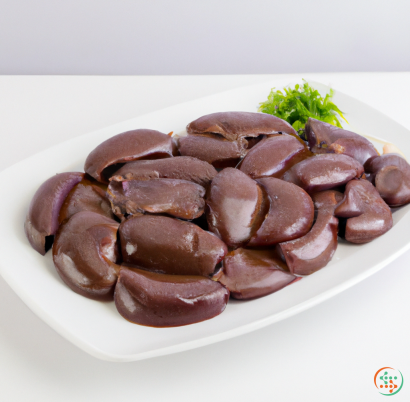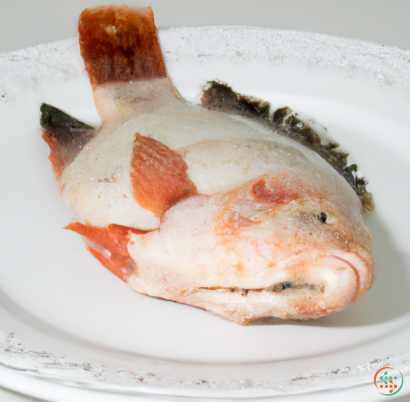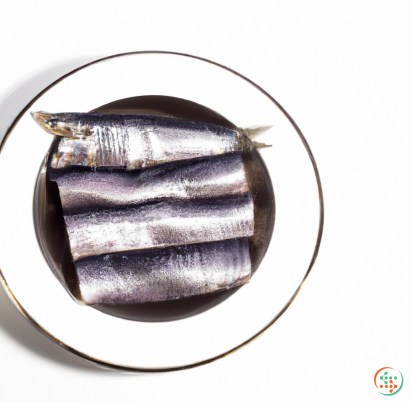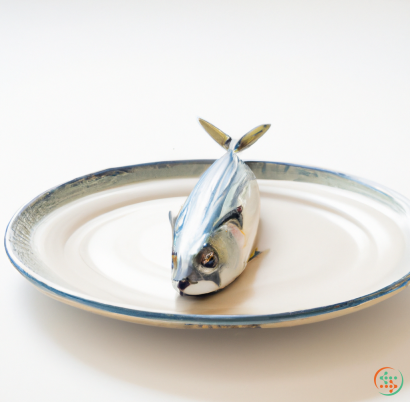Carp
A carp is a freshwater fish that has been a part of the human diet for thousands of years. It's a hardy, long-lived fish with an ancient history that traces back as far as the 15th century. Carp have a long-standing reputation as a delicious food source, as both a recreational and commercial fish, and as an icon of sustainable aquaculture.
The carp family is found in rivers, lakes, streams, and ponds across Eurasia and the Americas. They are large, hardy fish characterized by a large scales, adipose fins, an elongated body, and a unique set of barbels (whisker-like structures) that help them to detect food.
Carp vary in color depending on the season and the region. In general, common carp are green, yellowish-green, brown or black. Their coloration helps them blend into their environment and avoid predation.
In terms of nutrition, carp are among the most nutrient-rich fish. A three ounce serving of carp has 18 grams of protein and provides more than the recommended daily value of vitamins A, E, and D, as well as phosphorus and iron. Carp contain omega-3 fatty acids, which are essential for maintaining cell integrity and proper brain function. Omega-3 also play an important role in reducing inflammation and lowering the risk of heart disease.
Carp can also be used as a primary source of income, especially in societies with limited resources. Fishermen make a living out of trapping and selling individual carp, while some use aquaculture to cultivate large carp populations. This helps families, villages, and communities develop better food security and a reliable financial income.
When it comes to preparing carp, there is no shortage of options, as they can be cooked using a variety of methods. Common techniques include smoking, shallow or deep frying, steaming, and grilling. Carp are a delicacy in many countries, including Bulgaria, China, Hungary, and Japan, where they've traditionally been served as part of festivals and celebrations.
Aside from its culinary appeal, carp have also been bred for science and research purposes. Carp can be used as model organisms, whose characteristics can be studied and compared to those of humans. They are also commonly used in genetic research and for studies on health and behavior.
Whether you are looking for a delicious meal or a research specimen, carp are an interesting fish to explore. With a long history, an abundance of uses, and a wide range of nutritional benefits, they are a great addition to any aquatic enthusiast’s collection.
Throughout the ages, carp has been considered an iconic fish. Whether it’s the traditional carp streams or the open water sashimi-grade sushi markets, carp have become a mainstay in dinner tables around the world. But how does a carp go from the waters of its natural environment to the dinner plate?
What is Carp?
Carp (Cyprinus carpio) is a species of siluriform freshwater fish in the family Cyprinidae. It is native to Europe, Asia and Africa and has been introduced to much of the rest of the world. It is a popular fish for sport fishing, as well as a common food source in some countries. Carp have been cultivated for centuries for food, culture, and even for ornamental uses.
The Anatomy of Carp
Carp are relatively large and heavily built fish compared to other fish species. They typically range from 30–120 cm (12–47 in) in length and weight from 1–15 kg (2.2–33 lb). The body of a carp is somewhat elongated, with a scaleless, laterally flattened head and body and a deeply forked tail. The skin is usually dark gray or olive-green in color, but may vary depending on the region where the fish is from. The underside is usually a lighter shade of gray. Carp have large scales that are usually brown and bony plates along the back and sides of the body, which help protect them from predators. The eyes of carp are large and brightly colored, including yellow, orange, and red.
The Reproduction of Carp
Like all fish, carp reproduce by laying eggs. Juvenile carp can reach reproductive maturity at a wide range of ages and sizes, depending on the species and the environmental conditions they are in. Carp are typically sexually mature at 2-3 years of age, but in some cases they can mature as early as 1 year of age.
Adult carp can spawn multiple times a year and will usually travel to spawn in areas with higher water temperatures and optimal spawning grounds. During the spawning season, carp typically spawn in shallow water, lay their eggs in depressions in the bottom of the aquatic habitat, and then the adults return to deeper water.
Carp eggs are difficult to see due to their light hue and small size, ranging from 0.2-0.25 millimeters. Each female carp can lay several hundred thousand eggs, and the eggs hatch in 2 to 5 days, depending on the water temperature. During hatching, the carp larvae remain near the surface until they become more developed then become more aggressive and move to deeper waters.
The Lifecycle of Carp
Carp generally have a few different lifecycles depending on the species, and can reach a wide range of ages, from 1 to 20 years old. Immature fish tend to remain in shallow water where they feed on bottom dwelling organisms like insect larvae, algae, and other small invertebrates. As carp mature, they usually move to deeper water, where they feed more actively on larger prey items such as mussels, snails, and aquatic plants.
Carp are slow growing and often take several years to reach a sizeable size. In their natural habitats, carp will stay in the same areas until they are caught or die, but they can also move around different areas, depending on the food availability or changing water conditions.
From Water to Table
How do carp make it from their natural habitats to the dinner plate? There are different methods depending on the needs and regulations of the particular location where they are being harvested. Generally speaking, however, the process can be broken down into four steps: catching, transporting, processing, and distribution.
Catching
Carp can be caught by various methods including angling (fishing with a rod and reel), netting, spear fishing, and electro-fishing (using electrical current to stun the fish). Depending on the regulations of the area and the method used, the catch can range from prized sport fish to large quantities of commercial fish.
Transporting
Once caught, carp are usually transported using specialized carriers such as tanks, coolers, and boxes. They must be kept in well-oxygenated water with a suitable temperature range to ensure their survival during the journey. The length of the journey and the conditions of the transport vehicle can greatly affect the well-being of the carp.
Processing
Upon arriving at the processor, the carp are cleaned, weighed, and inspected for freshness and quality. The processors then determine what type of product they will produce (such as whole fish, fillets, smoked, canned, etc.). The carp are usually frozen during the processing, which helps retain their freshness and prevents spoilage.
Distribution
Once processed, the carp is prepared for distribution. This may include packaging and labeling for retail outlets, exporting to other countries, or transporting directly to restaurants and homes for immediate consumption.
Conclusion
From the wilds of their natural habitat, to the cold steel of the processing facility, to the warm kitchen of the home, carp go through a long journey before they can finally make it to the dinner plate. Through proper handling, storage, and monitoring, we can ensure that carp are always fresh and delicious freshly prepared meals.
| Vitamin A | 0.01 mg | |
| Vitamin C | 0.0016 grams | |
| Vitamin B1 | 0.14 mg | |
| Vitamin B2 | 0.07 mg | |
| Vitamin B3 | 0.0021 grams | |
| Vitamin B5 | 0.87 mg | |
| Vitamin B6 | 0.22 mg | |
| Vitamin B9 | 0.017 mg | |
| Vitamin B12 | 0.00147 mg |
| Calcium | 0.052 grams |
Daily Value 1.3 g
|
| Iron | 0.00159 grams |
Daily Value 0.018 g
|
| Magnesium | 0.038 grams |
Daily Value 0.4 g
|
| Phosphorus | 0.531 grams |
Daily Value 1.25 g
|
| Potassium | 0.427 grams |
Daily Value 4.7 g
|
| Sodium | 0.063 grams |
Daily Value 2.3 g
|
| Zinc | 0.0019 grams |
Daily Value 0.011 g
|
| Copper | 0.07 mg |
Daily Value 0.9 mg
|
| Manganese | 0.05 mg |
Daily Value 0.0023 g
|
| Selenium | 0.0162 mg |
Daily Value 0.055 mg
|
| Tryptophan | 0.256 grams | |
| Threonine | 1.002 grams | |
| Isoleucine | 1.054 grams | |
| Leucine | 1.858 grams | |
| Lysine | 2.1 grams | |
| Methionine | 0.677 grams | |
| Cystine | 0.245 grams | |
| Phenylalanine | 0.893 grams | |
| Tyrosine | 0.772 grams | |
| Valine | 1.178 grams | |
| Arginine | 1.368 grams | |
| Histidine | 0.673 grams | |
| Alanine | 1.383 grams | |
| Aspartic Acid | 2.341 grams | |
| Glutamic Acid | 3.413 grams | |
| Glycine | 1.097 grams | |
| Proline | 0.808 grams | |
| Serine | 0.933 grams |
| Total Sugars | 0.131141 grams |
per 100g
|
| Myristic acid (14:0) | 0.15 grams |
|
| Palmitic acid (16:0) | 0.84 grams |
|
| Stearic acid (18:0) | 0.24 grams |
|
| Total Saturated fatty acids: | 1.23 g | |
| Erucic acid (22:1) | 0.52 grams |
|
| Oleic acid (18:1) | 1.47 grams |
|
| Palmitoleic acid (16:1) | 0.84 grams |
|
| Gadoleic acid (20:1) | 0.09 grams |
|
| Total Monounsaturated fatty acids: | 2.92 g | |
| Omega-3 Timnodonic acid (20:5) | 0.31 grams |
|
| Omega-3 Clupanodonic acid (22:5) | 0.11 grams |
|
| Linolenic acid (18:3) | 0.35 grams |
|
| Linoleic acid (18:2) | 0.66 grams |
|
| Total Polyunsaturated fatty acids: | 1.43 g | |
| Cholesterol | 0.08 grams |
|
| Total Sterols: | 0.08 g | |

